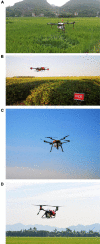Characteristics of unmanned aerial spraying systems and related spray drift: A review
- PMID: 36003827
- PMCID: PMC9395147
- DOI: 10.3389/fpls.2022.870956
Characteristics of unmanned aerial spraying systems and related spray drift: A review
Abstract
Although drift is not a new issue, it deserves further attention for Unmanned Aerial Spraying Systems (UASS). The use of UASS as a spraying tool for Plant Protection Products is currently explored and applied worldwide. They boast different benefits such as reduced applicator exposure, high operating efficiency and are unconcerned by field-related constraints (ground slope, ground resistance). This review summarizes UASS characteristics, spray drift and the factors affecting UASS drift, and further research that still needs to be developed. The distinctive features of UASS comprise the existence of one or more rotors, relatively higher spraying altitude, faster-flying speed, and limited payload. This study highlights that due to most of these features, the drift of UASS may be inevitable. However, this drift could be effectively reduced by optimizing the structural layout of the rotor and spraying system, adjusting the operating parameters, and establishing a drift buffer zone. Further efforts are still necessary to better assess the drift characteristics of UASS, establish drift models from typical models, crops, and climate environments, and discuss standard methods for measuring UASS drift.
Keywords: downwash airflow; drift measurement; relative movement; spray drift; unmanned aerial spraying systems.
Copyright © 2022 Chen, Douzals, Lan, Cotteux, Delpuech, Pouxviel and Zhan.
Conflict of interest statement
The authors declare that the research was conducted in the absence of any commercial or financial relationships that could be construed as a potential conflict of interest.
Figures





Similar articles
-
Field evaluation of spray drift and nontargeted soybean injury from unmanned aerial spraying system herbicide application under acceptable operation conditions.Pest Manag Sci. 2023 Mar;79(3):1140-1153. doi: 10.1002/ps.7285. Epub 2022 Nov 24. Pest Manag Sci. 2023. PMID: 36349383
-
Assessing the potential spray drift of a six-rotor unmanned aerial vehicle sprayer using a test bench and airborne drift collectors under low wind velocities: impact of atomization characteristics and application parameters.Pest Manag Sci. 2024 Dec;80(12):6053-6067. doi: 10.1002/ps.8334. Epub 2024 Jul 19. Pest Manag Sci. 2024. PMID: 39030971
-
Environmental, bystander and resident exposure from orchard applications using an agricultural unmanned aerial spraying system.Sci Total Environ. 2023 Jul 10;881:163371. doi: 10.1016/j.scitotenv.2023.163371. Epub 2023 Apr 10. Sci Total Environ. 2023. PMID: 37044339
-
Challenges and opportunities of unmanned aerial vehicles as a new tool for crop pest control.Pest Manag Sci. 2023 Nov;79(11):4123-4131. doi: 10.1002/ps.7683. Epub 2023 Sep 12. Pest Manag Sci. 2023. PMID: 37494136 Review.
-
Research on Methods Decreasing Pesticide Waste Based on Plant Protection Unmanned Aerial Vehicles: A Review.Front Plant Sci. 2022 Jul 7;13:811256. doi: 10.3389/fpls.2022.811256. eCollection 2022. Front Plant Sci. 2022. PMID: 35873963 Free PMC article. Review.
Cited by
-
Evaluationof compact air-induction flat fan nozzles for herbicide applications: Spray drift and biological efficacy.Front Plant Sci. 2023 Feb 3;14:1018626. doi: 10.3389/fpls.2023.1018626. eCollection 2023. Front Plant Sci. 2023. PMID: 36818846 Free PMC article.
-
Droplet distribution and mitigation of occupational exposure risk in eucalyptus sprout eradication using a remotely piloted aircraft.Front Plant Sci. 2025 Jan 17;15:1504608. doi: 10.3389/fpls.2024.1504608. eCollection 2024. Front Plant Sci. 2025. PMID: 39898262 Free PMC article.
-
Optimization of Operational Parameters of Plant Protection UAV.Sensors (Basel). 2024 Aug 8;24(16):5132. doi: 10.3390/s24165132. Sensors (Basel). 2024. PMID: 39204829 Free PMC article.
-
Evaluation of aerial spraying application of multi-rotor unmanned aerial vehicle for Areca catechu protection.Front Plant Sci. 2023 Feb 28;14:1093912. doi: 10.3389/fpls.2023.1093912. eCollection 2023. Front Plant Sci. 2023. PMID: 36925752 Free PMC article.
-
Spraying Effects of UAV Application on Droplet Effectiveness in Two Vine Trellis Systems of High-Slope Terrace Vineyards.Plants (Basel). 2025 May 13;14(10):1452. doi: 10.3390/plants14101452. Plants (Basel). 2025. PMID: 40431017 Free PMC article.
References
-
- Ahmad F., Zhang S., Qiu B., Ma J., Xin H., Qiu W., et al. (2022). Comparison of water sensitive paper and glass strip sampling approaches to access spray deposit by UAV sprayers. Agronomy 12:1302. 10.3390/agronomy12061302 - DOI
-
- Al Heidary M., Douzals J. P., Sinfort C., Vallet A. (2014). Influence of spray characteristics on potential spray drift of field crop sprayers: a literature review. Crop Prot. 63 120–130. 10.1016/j.cropro.2014.05.006 - DOI
-
- ASAE ANSI/ASABE (2020). Spray nozzle classification by droplet spectra. Standard 572.3. St. Joseph, MI: American Society of Agricultural and Biological Engineers.
-
- Bartzanas T., Kacira M., Zhu H., Karmakar S., Tamimi E., Katsoulas N., et al. (2013). Computational fluid dynamics applications to improve crop production systems. Comput. Electron. Agric. 93 151–167. 10.1016/j.compag.2012.05.012 - DOI
Publication types
LinkOut - more resources
Full Text Sources

